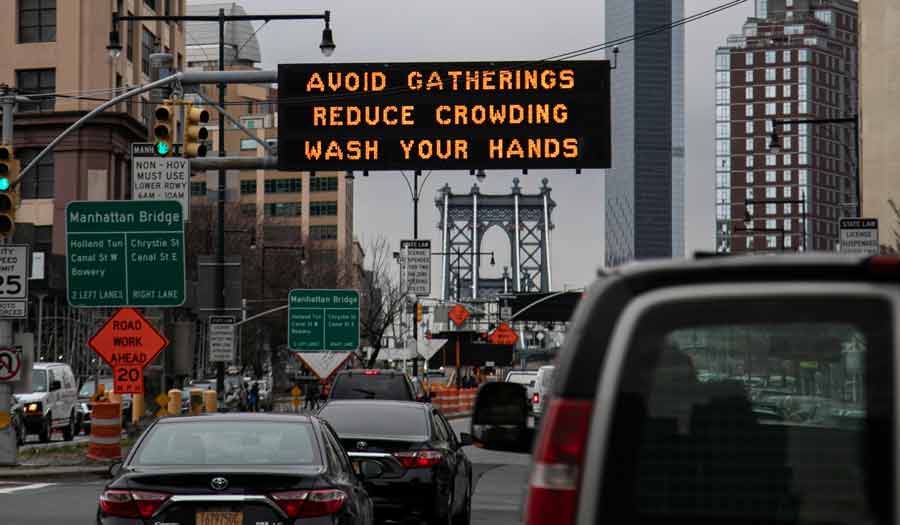 AP/Wong Maye-E
AP/Wong Maye-E
Article
Learn the why behind the headlines.
Subscribe to the Real Truth for FREE news and analysis.
Subscribe NowAs coronavirus cases continue to increase, there is something else spreading like a virus: misinformation. It can seem impossible to separate fact from fiction among rampant rumors and deliberate efforts to mislead. We at The Real Truth magazine are committed to bringing just that: truth. The articles we produce arm readers with ways to verify what they are learning is correct.
Here are a number of methods to ensure you can trust what you read on the internet.
Look for the Source
We are more likely to believe things our friends tell us—that is human nature. It is why rumors spread and why misinformation travels on social media. It is also why the chain text message warning of a nationwide lockdown worked so well: Everyone heard it from a friend of a friend who “knows someone.”
Be wary of important-sounding information that is not coming from a clear, authoritative source, such as local government agencies and health departments, or national and international public health institutes such as the Centers for Disease Control and Prevention and the World Health Organization. Posts may also claim that a politician said or did something. You can check that information through legitimate news outlets or the candidates’ own verified social media accounts.
CDC and the WHO
The top public health institutes in the United States and other countries, along with the WHO, are some of the most trusted sources of information about the outbreak. They provide the latest statistics, advisories and guides on everything from sanitizing your home to managing stress.
Dr. Jessica Justman, an infectious disease expert at Columbia University, said the sheer amount of information online about the coronavirus pandemic can quickly become overwhelming. That is one reason she encourages people to check the websites of the CDC and the WHO.
“It’s not just misinformation, it’s also a lack of good information,” Dr. Justman said. “There’s so much information out there that many people are just saying ‘I can’t read it, it makes me too anxious.’”
“Go straight to the source,” she said.
Act Like a Journalist
“Everyone right now is trying to figure out: What is going on? What do I need to know? Who can I trust?” said John Silva, director of education at the News Literacy Project, a Washington D.C.-based nonprofit that works with educators to teach students how to navigate the news.
Mr. Silva said anyone searching for accurate information about the virus needs to act like a journalist by verifying suspicious claims.
Be wary of information from groups or news organizations you do not know—in some cases the groups behind misinformation create websites and social media accounts that look like a legitimate news organization. Remember that there is a difference between news stories and opinion pieces. News stories should include the source of the information. If there is no source or attribution, be suspicious.
In addition to seeking authoritative sources, journalists also seek to confirm information from multiple sources. Even if a news outlet is at first alone in reporting a big development, others should soon follow. If this does not happen, it could be a red flag.
Pause, Take a Breath
A 2018 study by MIT researchers found that false news travels faster than real news—often much faster. That is because it is often designed to grab people’s attention by connecting with their emotions such as fear or outrage. The researchers, who studied how false news travels on Twitter, also found that misinformation spreads quickly because people retweet it, not due to bot activity. It is easy to get caught up in the moment and retweet a terrifying headline before reading the accompanying article. But pausing before reposting can save you from embarrassment and prevent falsehoods from spreading further.
Do Not Believe Everything You See
Those looking to exploit people’s fears around coronavirus are using a variety of techniques to sow confusion. False news articles are just a small part of this.
Photos and videos can be edited and altered, and real images can be presented out of context. Again, it helps to look for the source. Google’s reverse image search can help find the origins of a photo. For videos, take a look at who uploaded it—was it a random user? A news outlet? The CDC?
Americans have a duty not to add to an already anxious time by spreading misinformation that could alarm others—or put them at risk, said Dr. Ruth Parker, a physician at Emory University School of Medicine in Atlanta and an expert on health literacy.
“It’s a scary time,” Dr. Parker said. “We don’t want to add fuel to the fire. Good information won’t cure us, but it will help to calm us.”
When You Land on a News Site…
Yet your desire to know the truth should not end with information about coronavirus. The web is chock-full of sites that pass off as news sources, but instead are platforms through which reporters share “fake news.” Web users should be very careful to consider whether to trust a site before doing so. Following are a list of characteristics that “fake” or poorly vetted news sites tend to have:
• Lack of details on an “About” page. This page is a valuable window into the background and history of a specific source. It provides information about its mission, staff members, or even physical location.
• Spelling errors, poor grammar, or unprofessional language. Even the largest news organizations will make mistakes. But if a site consistently contains errors or language that is crude or crass, has profanity—or is otherwise unusual compared to professional reports—disregard the source.
• Bad design. A website that is difficult to navigate, full of “click bait” advertisements (for example, “One Weird Trick Will Save You Thousands”), or looks disorganized and unprofessional is a sign it does not have staff devoted to creating an overall quality product for news viewers.
• Negative reviews by “fact-checking” sites. A good rule of practice is to perform a web search on the name of any news outlet you are visiting for the first time. If many of the results are from fact-check websites such as Snopes and FactCheck.org—steer clear! While fact-checking sources also have biases, they can generally help you scope out and rate the factuality of a news source or claims made by them.
• Questionable or vague sources. If a site claims that an “official” stated something, attempt to track down the source of the original quote. If nothing else comes up—or if the quote is attributed to someone who is not connected to the story—it is likely a bogus claim. If a credible source stated something of significance, it “would garner media coverage beyond a website you’ve never heard of,” FactCheck.org stated.
• Lack of details in article. Look for bylines, dates, information on photographs (captions and sources), and make sure dates line up with a story. A so-called news site will often use a photograph that does not pertain to the claim it is making, or could quote an event that happened years or decades ago (without saying so) and erroneously use it in context with a current development.
This article contains information from The Associated Press.
- Real Truth Magazine Articles
- MEDIA
 Why Christians Must Watch the News
Why Christians Must Watch the News


